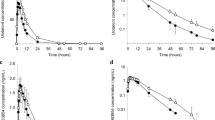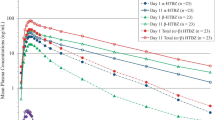Abstract
Objective
The aim of our study was to investigate the effects of multiple doses of paroxetine on the pharmacokinetics, safety, and tolerability of a single oral 10-µg dose of ramosetron.
Methods
This was an open, one-sequence crossover design study. On day 1, healthy male and female subjects were administered a single dose of 10 μg ramosetron. On the morning of day 3, the subjects were administered paroxetine to reach steady state, which consisted of morning doses of 20 mg on days 3–12. The dose on day 11 was administered in combination with a single dose of 10 μg ramosetron.
Results
In subjects genotyped as extensive CYP2D6 metabolizers, coadministration of paroxetine with ramosetron resulted in an increase in area under the curve from 0 to infinity (AUC0-inf) and the peak concentration (Cmax) of ramosetron by 1.14-fold (90% confidence interval (CI): 1.07–1.22) and by 1.06-fold (90% CI: 1.00–1.11), respectively.
Conclusions
It can be concluded that the single-dose pharmacokinetic profile of ramosetron 10 μg is not affected to a clinically relevant degree by paroxetine 20 mg once daily administered for 10 days.

Similar content being viewed by others
References
Gralnek IM, Hays RD, Kilbourne A, Naliboff B, Mayer EA (2002) The impact of irritable bowel syndrome on health-related quality of life. Gastroenterol 119:654–660
Gershon MD (1999) Review article: roles played by 5-hydroxytryptamine in the physiology of the bowel. Aliment Pharmacol Ther 13(Suppl 2):15–30
Delvaux M, Louvel D, Mamet JP, Campos-Oriola R, Frexinos J (1998) Effect of alosetron on responses to colonic distension in patients with irritable bowel syndrome. Aliment Pharmacol Ther 12:849–855
Forster JM, Houghton LA, Whorwell PJ (1997) Alosetron shows colonic transit in patients with irritable bowel syndrome (IBS). Gastroenterol 112:A732. (Abstract)
Northcutt AR, Camilleri M, Mayer EA et al (1998) Alosetron, a 5HT3-receptor antagonist, is effective in the treatment of female irritable bowel syndrome patients. Gastroenterol 114:A812. (Abstract)
Nakashima M, Kanemaru, M, Miura, H, Takeshige, T, Atsuta, Y (1995) Phase I clinical study of oral ramosetron. Rinsyo to Kenkyu 72(11):264–278
Astellas Pharma Inc., Investigator’s Brochure (2005) YM060 Ramosetron Hydrochloride
Castle MZD, Silk DBA, Libby GW (2004) Review article: the rationale for antidepressant therapy in functional gastrointestinal disorders. Aliment Pharmacol Ther 19:969–979
Clouse RE, Lustman PJ (2005) Use of psychopharmacological agents for functional gastrointestinal disorders. Gut 54:1332–1341
American Gastroenterological Association Medical Position Statement: Irritable Bowel Syndrome (2002) Gastroenterol 123:2105–2107
Creed F, Fernandes L, Guthrie E et al (2003) The cost effectiveness of psychotherapy and paroxetine for severe irritable bowel syndrome. Gastroenterol 124:303–317
Lea R, Whorwell PJ (2003) New insights into the psychosocial aspects of irritable bowel syndrome. Curr Gastroenterol Rep 5:343–350
Crewe HK, Lennard MS, Tucker GT, Woods FR, Haddock RE (1992) The effect of selective serotonin re-uptake inhibitors on cytochrome P4502D6 (CYP2D6) activity in human liver microsomes. Br J Clin Pharmacol 34:262–265
Schwartz JB (2003) The influence of sex on pharmacokinetics. Clin Pharmacokinet 42:107–121
Koch KM, Palmer JL, Noordin N, Tomlinson JJ, Baidoo, C (2002) Sex and age differences in the pharmacokinetics of alosetron. Br J Clin Pharmacol 53:238–242
Pritchard JF, Bryson JC, Kernodle AE, Benedetti TL, Powell JR (1992) Age and gender effects on ondansetron pharmacokinetics: evaluation of healthy aged volunteers. Clin Pharmacol Ther 51:51–55
Koch KM, Corrigan BW, Manzo J et al (2004) Alosetron repeat dose pharmacokinetics, effects on enzyme activities, and influence of demographic factors. Aliment Pharmacol Ther 20:223–230
Dixon CM, Colthup PV, Serabjit-Singh CJ et al (1995) Multiple forms of cytochrome P450 are involved in the metabolism of ondansetron in humans. Drug Metab Dispos 23:1225–1230
Author information
Authors and Affiliations
Corresponding author
Rights and permissions
About this article
Cite this article
Kadokura, T., den Adel, M., Krauwinkel, W.J.J. et al. The effect of paroxetine on the pharmacokinetics, safety, and tolerability of ramosetron in healthy subjects. Eur J Clin Pharmacol 64, 605–609 (2008). https://doi.org/10.1007/s00228-008-0472-z
Received:
Accepted:
Published:
Issue Date:
DOI: https://doi.org/10.1007/s00228-008-0472-z




